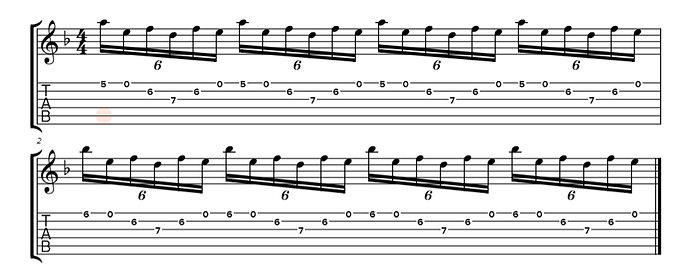In principle, both ascending and descending forms can be performed smoothly with the 902 motion.
While wrist crosspicking movements can be done quite quickly, they are inherently slower than linear movements. We can feel when we are approaching the limits the capability of our crosspicking movement. In attempt to make the movements feel “easy” again, it’s natural to eliminate the curvature and adopt a linear path. To be able to escape in both directions then requires that we change orientation, or that we have a specialized helper movement to handle the problematic direction of escape.
What’s happening here is that Andy feels that it would be easier to achieve what he want by abandoning his 902 movement and switching to the linear 802 movement introducing rotations to change escape directions.
However, keep in mind that this is an intuitive process. Where Andy feels it becomes preferable to change his movement patterns is dependent on context, and is kinaesthetic experience of that particular context. As such, there may be discrepancies between ascending and descending, inside and outside changes, notes per string, etc.
This is completely natural. We shouldn’t insist upon uniformity of our form in all contexts, if we find a solution which works for us in a particular context, that’s all we really need. We may have personal idiosyncrasies or interesting artifacts in our form which persist, and that really isn’t a problem.
As an interesting example, Shawn Lane had a completely redundant rotation when playing ascending sixes across strings. It’s vestigial and has absolutely no function in that particular context. However, that rotation is necessary when playing a repeating ascending 6 on two strings, or when ascending with sixes involving string skips, and it may be that that rotation is an artifact from one of those contexts.
When playing descending sixes across strings he had no redundant rotation. For whatever reason, Shawn intuitively felt that a redundant rotation was not necessary in that context.
I believe many of Eric Johnson’s idiosyncratic finger and thumb movements while picking are somewhat similar, being contextual artifacts which are sometimes completely vestigial.
My own guitar teacher had a very idiosyncratic “thumb flick” movement on a particular picking pattern that was completely unnecessary, he was aware of it and knew it served no function, but he couldn’t remove it from his playing. I’m not sure that it was even worth the effort, the thumb flick didn’t prevent him from playing the pattern perfectly and consistently.
My conclusion then, is that if these idiosyncrasies, peculiarities or vestigial artifacts arise in our playing and they don’t negatively affect our playing, we should just accept them as something which occurs in motor learning and not worry about removing them.







